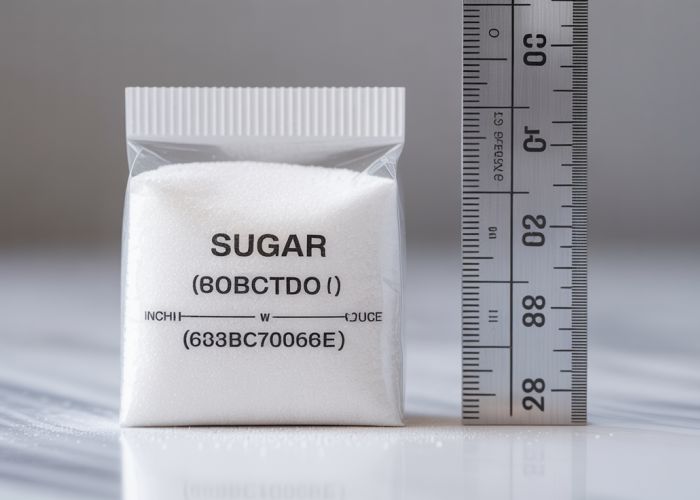The National Institute of Standards and Technology (NIST) establishes certain dimensional standards, and this context helps appreciate why sugar packet dimensions are so meticulously controlled. A key factor influencing these dimensions is the efficient functioning of packaging machinery, particularly those manufactured by companies like Bosch Packaging Technology. Consequently, these dimensions directly affect consumer convenience and are closely studied within the field of ergonomics. Understanding sugar packet dimensions is not merely about size, but about the interplay of industry standards, manufacturing precision, and user experience.

Sugar Packet Dimensions: Why This Tiny Size REALLY Matters!
Understanding the surprisingly significant role of "sugar packet dimensions" requires a multifaceted approach. This exploration delves into not just the physical size, but the practical, economic, and even psychological implications of these small packages. A well-structured article should cover the following areas:
I. Defining Sugar Packet Dimensions: A Precise Measurement
The article must begin with a clear definition of standard "sugar packet dimensions." Imprecision here compromises the entire discussion.
- Typical Dimensions: Provide measurements in both inches and millimeters (e.g., "Typically, a sugar packet measures approximately 2.25 inches in length and 1.5 inches in width, which translates to roughly 57 mm x 38 mm.").
- Variations and Tolerances: Acknowledge that slight variations exist based on manufacturer, brand, and regional standards. Mention typical tolerance ranges (e.g., "A tolerance of +/- 0.1 inches or 2.5 mm is generally accepted.").
- Visual Representation: Ideally, include a diagram or image clearly indicating the length, width, and, if applicable, the depth of the packet.
II. The "Just Right" Quantity: How Sugar Packet Dimensions Dictate Portion Control
The size isn’t just arbitrary; it’s intrinsically linked to the intended single-serving amount of sugar.
- Standard Serving Size: Explain the prevailing recommendation for a single serving of sugar (e.g., "A standard sugar packet contains approximately 4 grams (or 1 teaspoon) of granulated sugar."). Connect this to dietary guidelines.
- Dimensional Limits: Discuss how the "sugar packet dimensions" constrain the volume and, therefore, the maximum amount of sugar that can be packaged.
- Consumer Perception: Analyze how this pre-portioned quantity affects consumer behavior regarding sugar consumption. Does it encourage or discourage adding more than one packet?
- Comparison to Bulk Sugar: Contrast the control offered by packets to the potentially larger amounts added when using sugar bowls or dispensers.
III. Efficiency in Manufacturing, Packaging, and Distribution: The Logistical Impact
The "sugar packet dimensions" directly impact the ease and cost-effectiveness of mass production and delivery.
- Machine Optimization: Explain how standardized dimensions allow for efficient automation in sugar filling, packet sealing, and boxing.
- Material Usage: Smaller dimensions naturally translate to less packaging material (paper, glue, ink), reducing overall costs and potentially environmental impact.
- Paper Thickness: Briefly mention the typical paper stock used and how it contributes to the overall package dimensions.
- Storage and Transportation: Discuss the optimization of space in storage facilities and during transportation, facilitated by uniform "sugar packet dimensions."
-
Table Illustrating Cost Savings:
Factor Impact of Smaller Dimensions Packaging Material Lower material costs per packet; Reduced environmental footprint Production Speed Faster filling and sealing process due to standardized dimensions Shipping Density More packets can be shipped per container/truck
IV. Marketing and Branding Considerations: The Visual "Canvas"
While functional, the surface area dictated by "sugar packet dimensions" also serves as a prime marketing space.
- Brand Visibility: How do companies utilize the limited space for logos, slogans, and promotional messages?
- Design Constraints: Analyze the challenges designers face when working within the dimensional limitations.
- Color and Typography: Discuss the strategic use of color palettes and font choices to maximize visual impact on such a small canvas.
- Regional and Cultural Differences: Examine how "sugar packet dimensions" and designs might vary based on local customs and preferences.
V. Environmental Concerns and Sustainability: Reducing the Footprint
The environmental impact of disposable sugar packets necessitates considering alternative materials and waste reduction strategies.
- Biodegradable Options: Explore the use of biodegradable or compostable packaging materials and their impact on "sugar packet dimensions" (if any).
- Recycling Challenges: Address the common challenges associated with recycling sugar packets (e.g., small size, potential contamination with sugar residue).
- Alternatives to Packets: Discuss potential replacements like sugar dispensers or encouraging consumers to use their own sweetener containers.
- Future Trends: Consider emerging trends in sustainable packaging that might affect the future of "sugar packet dimensions."
Sugar Packet Dimensions: Frequently Asked Questions
Here are some common questions about why the size of sugar packets is so important.
Why are sugar packets always the same size and shape?
The standardized size ensures consistent portion control. This helps consumers easily estimate sugar intake and manufacturers accurately fill packets on high-speed machines. The standard also simplifies storage and display.
What are the typical sugar packet dimensions?
Generally, a standard sugar packet measures approximately 2-3 inches long and 1-2 inches wide. The exact sugar packet dimensions can vary slightly between manufacturers. However, they are always in similar proportion.
How does the sugar packet size impact cost efficiency?
Standardized sugar packet dimensions enable mass production and efficient packaging. This reduces material waste and lowers production costs. The resulting savings are passed to consumers and businesses alike.
What are the advantages of the small size of the sugar packet?
The compact sugar packet dimensions make them incredibly portable and convenient. They easily fit in pockets, purses, and condiment holders. This makes them ideal for on-the-go use in restaurants, cafes, and offices.
So, the next time you tear open a sugar packet, remember all the thought that went into those tiny sugar packet dimensions! Hope this was sweet food for thought!